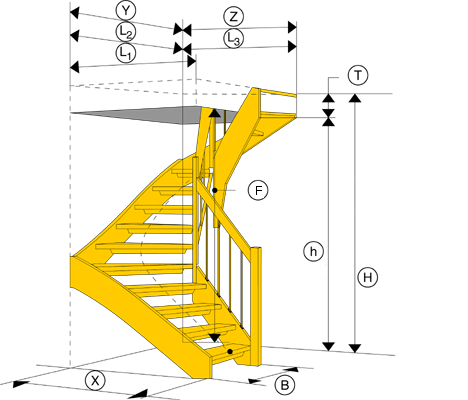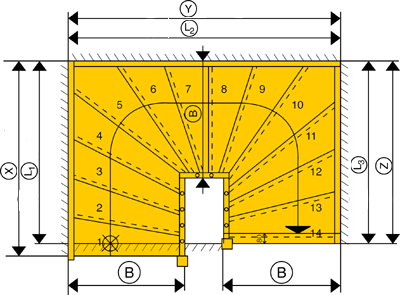Space requirements important dimensions for a U-Staircase
How much space does a Half-turned staircase require?
Requirements:
The step depth is 250 mm, measured at the tread line, which is placed 1/3 into the running width of the staircase.
For wider staircases, the tread line is moved inwards and takes up more space.
The dimensions in the table include an end step of 80 mm but not the 30 mm step at the beginning of the staircase.
How to calculate:
- Measure your total height from floor below to floor upstairs (H)
- Choose the number of rises. (For example, if you have a floor height of 2650 mm, you choose 14 step heights.)
- Choose the width of the staircase. (B).
- The measurement you will find in the table is the total sum of the horizontal lengths according to the drawing (X) and (Y). The flexibility is that you can adjust any horizontal length as long as the total sum is the same as the value in the table.

How to measure a half-turned staircase:
Designations
H = Stair height – measured vertically from the floor below to the floor upstairs
h = Room height – measured from the floor below to the
T = Well thickness.
(with the measurments of the room height and the well thickness you can calculate the head room)
B = The total staircase width. .
X = The horizontal measurement of the first flight of the staircase.
Y = The horizontal measurement of the second flight of the staircase.
Z = The horizontal measurement of the third flight of the staircase.
L1 = The horizontal measurement of the well opening at the X-measurement of the staircase.
L2 = The horizontal measurement of the well opening at the Y-measurement of the staircase.
L3 = The horizontal measurement of the well opening at the Z-measurement of the staircase.
(It doesn’t matter if you have plenty of room for the stairs downstairs.
The size of the stairwell – and the height of the room – determines how big the stairs can be.)


